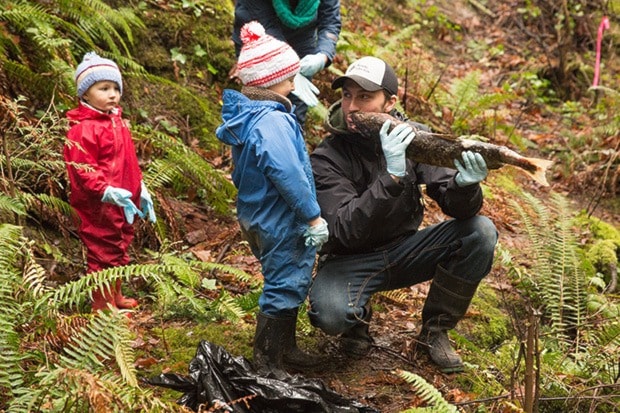Peter McCully gets asked a lot about why he throws dead salmon into local rivers.
Since 1992, the biologist from the Howard English Hatchery has worked with the Friends of Mount Douglas Park Society for its annual salmon carcass toss at Douglas Creek, which sees members plant salmon carcasses in the water to encourage spawning.
“It’s like fertilizing the river: the nutrients that are carried in the carcasses of the salmon have been acquired at sea,” said McCully. “They’re called marine-derived nutrients, and they’re what make our streams and rivers so bountiful.”
Dozens of volunteers turned out for the salmon toss, along with Saanich councillors Judy Brownoff and Vicki Sanders, and Saanich South MLA Lana Popham.
Because of the rainfall on the west coast, McCully said the rain tends to wash out the nutrients from local streams, making them nutrient poor and negatively impacting their ability to support production of the bottom of the food chain.
However, with a little help from volunteers, Pacific salmon have a way of overcoming the washout of nutrients and eventually making streams more bountiful.
“The fish will come back and spawn once and then it will die,” he said. “All of that carcass is recycled into the food chain, and when the salmon is out at sea and it’s feeding, it accumulates what we call marine-derived nutrients. Things like nitrogen and carbon and phosphorus, and they’re the building blocks of the food chain in fresh water.
“That’s why we’re putting dead fish into the stream.”
The hatchery provided dozens of carcasses for the event, which gained permission from the Department of Fisheries and Oceans to move the salmon between watersheds. Volunteers also released juvenile coho into the creek, which are expected to stay in the creek until May before heading into the ocean and, with any luck, returning to spawn 18 months later.
“We did this last year, and we actually had coho come back last fall,” said McCully. “Things are happening, things are working.”
While the creek still needs nutrients to build the salmon population, McCully said the combined efforts of the society and the hatchery over the last 24 years have already made a significant impact to Douglas Creek.
“In the ensuing years, habitat restoration has been conducted, the water quality has improved to the point it supports fish,” he said. “All of this work, it doesn’t happen overnight – it involves a lot of people, a lot of effort, and in this case, a lot of time. It’s a work in progress.
“This is very much evidence of a community initiative that brings people together. It’s really a great showpiece of how volunteer power can make things work.”
